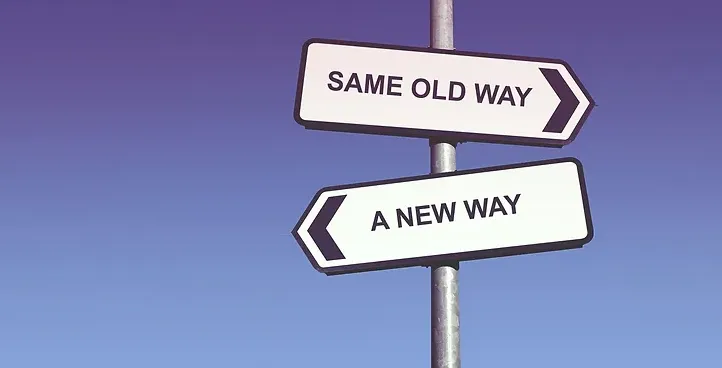The Social Communication Blog
By Linda Boverman

Our Thoughts: to Believe or Not to Believe?
Do our thoughts make us react in a complaining, victimized, despondent or static way?
Do they interpret normal sadness, even disappointment, as something bigger than it is, thus turning it into a sense of overwhelming depression, devastating doubt, and crippling anxiety?
Do they turn “little problems into big problems”?
In the typical population, this type of over-reactive thinking is often called being a “drama queen” or “drama king”. In my world of children and adults with learning and social differences, it is often called “dysregulating” or “going into survival mode” and can be even more pronounced.

Although I believe we will always have a certain amount of anxiety, I also believe our thoughts often run amok and create unnecessary inner havoc.
These problematic thoughts and feelings are often expectedand in some ways reasonable–as in challenging situations like divorce or death.
BUT…
They also can come and go in almost a blink of an eye or they last over an extended period of time.
They emerge in all areas of our lives–academics, the work force, and our relationships.
AND they lie to us–especially when we are feeling agitated.
When my brain does this, I am sometimes clear thinking and go about my business with a simple–
“Oh, well…”

But since I am a human beings, I often respond in way neither healthy nor helpful to myself or others.
One strategy –or maybe one thought–is I look at these behaviors and others as HABITS. Habits acquired over long periods of time often through extensive practice.

Although changing these habits often requires a lot of time, a lot of practice–and a fair amount of self-awareness–change is totally possible, even likely.
I know this from personal experience AND because brain research shows how changing our thinking–>changes our brains–>which changes our behavior–>which again changes our thinking AND our feelings.
WE CAN DO IT!

In my mind, there are 3 major STEPS:
NOTICING the old habit
DECIDING to change the habit
CREATING a new habit

NOTICING means deeply recognizing when our brains are over-zealous and unnecessarily stimulating depression, fear, and anxiety.

DECIDING is the motor that sets us on our way to creating a NEW habit.
Deciding we truly want to change is hugely powerful, especially when backed up by a drivng
GOAL.

CREATING a new habit means practicing strategies that have the power to change our brains and result in new habits.
At first, our children may resist, but when they realize they are getting attention for being less than competent, they often feel “creeped out”and learn new ways of getting attention. This also helps parents shift to giving positive attention.
The more we practice fear, depression, and anxiety, the more the survival brain center is activated, the more we are unhappy, often creating a spiral of unhappiness.
The more we practice courage, joy, and freedom, the more our creative, problem-solving and strategic thinking brain center is activated, spiralling happiness.

NOTICING ADDITIONAL BEHAVIORS(HABITS):
Over-focus on how uncomfortable we are
Not recognize that we misinterpret the social dynamics
Inaccurately read the situation leading to erroneous interpretations/judgements of our competence and behavior
Believe we have evidence for being anxious because we don’t have the skills or competencies not to be anxious (often when relating to others) or haven’t put in enough time or effort for a new habit to develop
Avoid taking on healing strategies as our own–instead think they are simply behaviors others want us to do
Listen to the “self-defeater coach” inside our heads instead of our “success coach”, making excuses and telling ourselves we have never been able to change so can’t change now.
Avoid learning new strategies and habits because the “dreaded” stress and discomfort is always part of the process of creating a new healthier habit
Have no awareness of the pride that accompanies success in social thinking and anxiety management
Default to the habit of anxiety, fear, and depression instead of “pushing through”, which changes our brains, creating new healthy habits that promote comfort, joy, competence, and success.
CREATING STRATEGIES THAT CAN HELP:
Lucky for us, many of the strategies we can teach ourselves and our children are simply doing the reverse of what we NOTICE. Other strategies include:
Recognizing that our brains are always learning from new experiences.
Awareness of our default patterns, i.e. what our brains are most comfortable with, is mandatory for changing them.
Knowing that “defaulting” into our old habits teaches our brains we can only do what we are used to doing.
Teaching our brains that we can do something new and different means pushing ourselves to learn and practice new strategies.
Accepting that transitioning to a new habit will feel more uncomfortable than the old habit.
Minimizing anxiety requires persistent work and practice of the new behaviors and strategies.
Anxiety is not going away without a fight.
IT’S A CHOICE: Are we going to default into habit or strategies?
WE MUST TALK TO OURSELVES USING WORDS LIKE: “Sounds like that is an excuse, what are you teaching your brain?”
IT’S UP TO US
DO WE WANT TO BELIEVE THE LIES OUR BRAINS TELL US,
OR
DO WE WANT TO BELIEVE WHAT WE KNOW TO BE TRUE?
ANXIETY AND SOCIAL COMPETENCIES—references:
How to Make Stress your Friend–Kelly McGonigal
Cool Kids Adolescent Anxiety Program (Lyneham, Schiering, Wignall and Rapee, 2006)
Helping Your Anxious Child (2nd edition Rapee, Wignall, SpenceCobham, Lyneham, 2008)
Michelle Garcia Winner – Spiral of Success and Spiral of Failure (www.socialthinking.com)
Beyond the Blues – An instant Help Book for Teens (Schab 2008)
Asperger Syndrome and Anxiety – A Guide to Successful Stress Management (Dubin 2009)
Perfectionism – What’s Bad About Being Too Good (Adderholdt, Goldberg 1999)
A FEW CHILDREN’S BOOKS:
Meet Thotso, Your Thought Maker (Rachel Robb Avery, 2008)
What’s a Thought–A Thought is a Lot (Jack Pransky and Amy Kahofer, 2012)
Your Fantastic Elastic Brain (JoAnn Deak, 2010)
The Owner’s Manuel for Driving your Adolescent Brain (JoAnn Deak and Terrence Deak, 2013)

Copyright 2023 . All rights reserved
lindaboverman@gmail.com
(213) 804-7750

